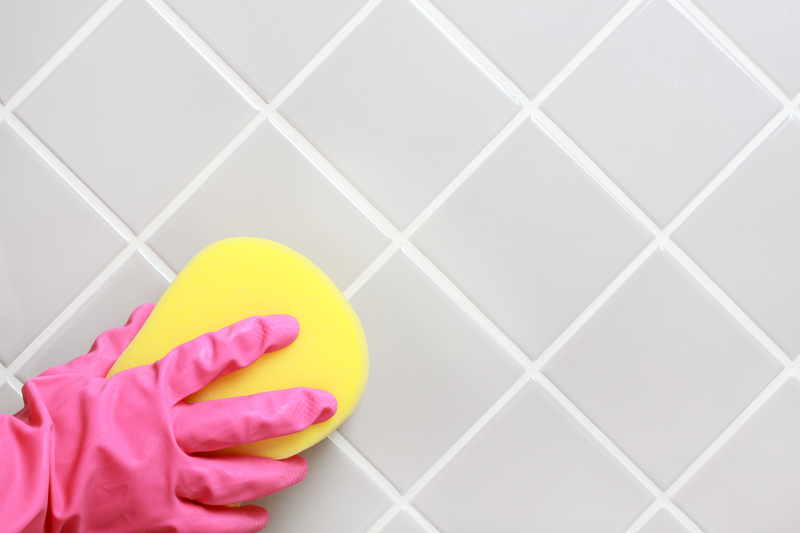Navigate the world of uPVC window frame cleaning with ease
Posted on 14/09/2025
Navigate the World of uPVC Window Frame Cleaning with Ease
If you're looking to navigate the world of uPVC window frame cleaning without stress or damage to your windows, you've come to the right place. uPVC, short for unplasticized polyvinyl chloride, is a highly popular material for window frames due to its durability, low maintenance, energy efficiency, and modern appearance. However, keeping these frames clean and sparkling can sometimes be challenging, especially if you're unsure of the proper cleaning methods and products. This comprehensive guide will provide you with everything you need to know for effective cleaning of uPVC window frames -- from gathering the right materials to mastering the best cleaning techniques.

Understanding uPVC Window Frames
Before diving into the specifics of uPVC window frame cleaning, it's important to understand the characteristics of this material. uPVC is:
- Durable and weather-resistant: It won't warp, rot, or rust - making it ideal for outdoor framing.
- Low Maintenance: Unlike wood, uPVC doesn't require frequent painting or staining.
- Cost-Effective: Affordable to manufacture and install.
- Energy Efficient: Acts as an insulator, keeping heat in during winter and out in summer.
The Importance of Regular uPVC Window Frame Cleaning
Consistent cleaning of your uPVC window frames is vital for several reasons:
- Enhances Curb Appeal: Clean frames boost your home's appearance, making windows look fresh and inviting.
- Prevents Discoloration: Dust, dirt, and pollutants can eventually stain white or colored uPVC, leading to yellowing or fading.
- Avoids Damage: Built-up grime can cause seals and mechanisms to deteriorate, leading to costly repairs.
- Improves Functionality: Clean frames and tracks ensure windows open and close smoothly.
- Prolongs Lifespan: Removing abrasive debris reduces wear and tear, extending the lifespan of the frames.
Essential Tools and Products for uPVC Frame Cleaning
Embarking on uPVC window cleaning is much easier when you have the right equipment. Here's a list of essential tools and products:
- Soft Cloths and Sponges: Microfiber cloths and non-abrasive sponges are perfect for wiping down surfaces without scratching.
- Mild Detergent: Regular dish soap diluted in warm water works wonders for routine cleaning.
- Soft-Bristled Brush: Ideal for reaching into corners, edges, and tracks.
- Spray Bottle: For applying diluted cleaning solutions directly to the frames.
- Vacuum Cleaner with Attachments: To remove dust and loose debris from tricky areas.
- White Vinegar: Effective against tough stains and mildew, especially when paired with baking soda.
- Specialized uPVC Cleaners: Available at hardware stores for stubborn marks or to restore shine.
- Non-scratch Scouring Pad (for Stubborn Stains): Be careful not to rub too hard.
- Rubber Gloves: For protecting your hands, especially if using chemical cleaners.
Preparation Before Cleaning uPVC Window Frames
Proper preparation helps ensure a smooth and effective cleaning process. Here's what you should do:
By adequately preparing, you minimize mess and make cleaning efficient and thorough.
Step-by-Step Guide: How to Clean uPVC Window Frames
1. Dust and Vacuum the Frames
Use a vacuum cleaner with the brush attachment to remove dust, cobwebs, and loose dirt from the frames, tracks, and sills. This prevents scratching during the wet cleaning process.
2. Wash with Soapy Water
Mix a small amount of mild detergent or dish soap in a bucket of warm water. Dip a soft cloth or sponge into the solution and gently wipe all surfaces of the frame. Pay extra attention to corners, edges, and any grooves where debris may hide.
3. Tackle Tough Stains and Discoloration
Sometimes, you'll encounter stubborn marks (such as mold, mildew, or ingrained dirt). For these:
- Mix white vinegar and water (equal parts) and apply to the stain. Let it sit for a few minutes before scrubbing with a soft-bristled brush.
- For extra cleaning power, sprinkle baking soda onto the stain before spraying with vinegar. The fizzing action helps loosen grime.
- If commercial uPVC frame cleaners are used, always follow manufacturer instructions and test on an inconspicuous area first.
4. Clean the Window Tracks and Hinges
Window tracks and hinges attract dust and debris, affecting window operation. Clean them using:
- A vacuum with a nozzle attachment
- A small, soft brush (like an old toothbrush)
- Q-tips for hard-to-reach areas
5. Rinse and Dry
Go over the cleaned areas with a cloth rinsed in clean water to remove any soapy residue, which can attract dust if left behind. Then, dry thoroughly with a microfiber cloth to prevent water spots and streaks.
6. Polish for Extra Shine (Optional)
If you want to bring out the gleam in your uPVC window frames, use a uPVC polish or restorer (specifically designed for your window type and color). Apply sparingly using a soft cloth. This step is purely for aesthetics and isn't required every cleaning cycle.
Common Mistakes to Avoid When Cleaning uPVC Window Frames
Avoiding the following mistakes will help ensure your uPVC frames stay in the best possible condition:
- Using Abrasive Cleaners: Scouring pads, steel wool, and harsh chemicals can scratch or pit the surface, leading to permanent damage.
- Skipping Regular Cleaning: Infrequent cleaning allows dirt to build up, making the process more challenging and potentially shortening lifespan.
- Neglecting Window Tracks: Ignoring tracks and hinges can lead to sticky operation and eventual mechanical problems.
- Leaving Cleaning Solution to Dry: Allowing soapy water or vinegar to dry on the surface can lead to streaks, residue, or discoloration.
- Cleaning in Direct Sunlight: Sun can cause cleaning agents to dry too quickly, leaving unwanted streaks.
How Often Should You Clean uPVC Window Frames?
To keep your windows looking their best, adhere to the following schedule:
- General surface cleaning: Every 2-3 months (or more often if you live in high-pollution or coastal areas)
- Deep cleaning and hinge/track maintenance: Every 6 months
- Spot cleaning for spills or bird droppings: As soon as possible to prevent staining
Dealing with Yellowed or Stained uPVC Frames
Over time, especially on white uPVC, you may notice yellowing or persistent stains. Don't panic--here are a few ways to remedy this:
- Try a uPVC cream cleaner: Specifically designed for restoring white uPVC surfaces, these non-abrasive creams can reduce yellowing.
- Use a paste of baking soda and water: Apply gently and rinse thoroughly.
- Avoid bleach: While tempting, bleach can damage the protective coating and worsen discoloration long-term.
- Consider professional restoration: If yellowing is severe or affects a large area, pros can use safe, powerful products to renew the frames.
Maintaining the Longevity of uPVC Window Frames
Regular cleaning is only part of the care. To ensure your uPVC window frames remain in top condition:
- Lubricate moving parts: Use a silicone spray on hinges, locks, and handles every 6-12 months.
- Check seals and gaskets: Ensure weatherstripping is intact for maximum insulation.
- Avoid placing sticky tapes or decorations: These can leave behind residue that is difficult to remove.
- Trim nearby plants: Overhanging branches or vines can scratch frames and deposit sap or pollen.
Eco-Friendly uPVC Window Frame Cleaning Solutions
If you're environmentally conscious or sensitive to harsh chemicals, there are many green options for safely cleaning uPVC surfaces:
- Vinegar and Water: Effective on glass and frames, especially for regular light cleaning.
- Baking Soda: A natural abrasive that won't scratch uPVC when used gently.
- Lemon juice: Can help dissolve lightly stuck-on grime and add a fresh scent.
- Castile soap: A gentle, biodegradable soap that's safe for most surfaces.
Troubleshooting Common uPVC Window Frame Issues
1. Stiff or Jammed Windows
Dust and grime in the tracks or hinges can cause windows to stick. Clean and lubricate all moving parts as described earlier.
2. Mysterious Streaks after Cleaning
Streaks are usually caused by:
- Using too much detergent
- Allowing cleaner to dry on the surface
- Cleaning in direct sunlight
3. Persistent Mildew or Mold
Use vinegar or a mild anti-fungal solution and keep frames dry afterward. Ensure good ventilation indoors to prevent recurrence.
4. Scratches on uPVC Surfaces
Fine scratches might be buffed out using a uPVC restorer or polish, but deep scratches typically require professional attention.

Professional vs DIY uPVC Window Frame Cleaning
Most uPVC window frame cleaning can be done with DIY methods, but certain scenarios call for professional expertise:
- Heavily stained or yellowed frames: Professionals have access to potent yet safe cleaning agents and techniques.
- Hard-to-reach windows on upper floors: Safety harnesses and specialized equipment may be needed.
- Time constraints: Hiring a service can be worth it for busy homeowners.
Summary: Enjoy Clean, Bright uPVC Window Frames All Year Round
Navigating the world of uPVC window frame cleaning is made simple when you use the right techniques, tools, and products. With regular care, you can keep your windows looking bright, clean, and inviting while protecting your investment and improving the value of your home.
- Use gentle, non-abrasive cleaners and tools.
- Clean regularly to prevent stubborn buildup and staining.
- Pay attention to tricky areas like tracks and hinges.
- Address stains or yellowing promptly with appropriate methods.
- Maintain hardware and seals for long-lasting performance.





